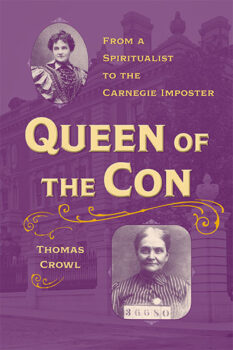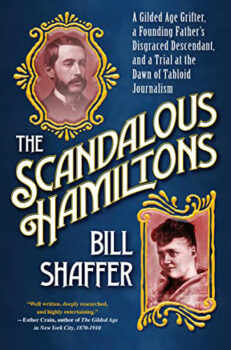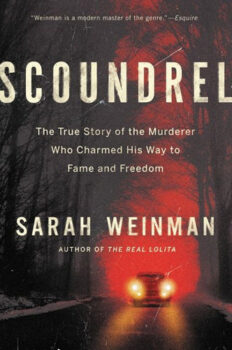Stranger Than Fiction
February 2023
Confidence Tricks
by Dean Jobb
When it came to name-dropping in the Gilded Age, there was no name bigger or more synonymous with wealth to be dropped than Andrew Carnegie. The industrialist and philanthropist was one of the richest Americans in history—richer, at one point, than oil magnate J.D. Rockefeller. And a clever con artist who called herself Cassie Chadwick made a fortune by posing as the great man’s illegitimate daughter.
 Thomas Crowl tells Chadwick’s incredible-but-true story in Queen of the Con: From a Spiritualist to the Carnegie Imposter (Kent State University Press), one of four recent true crime books that explore the crimes of a rogues’ gallery of con artists.
Thomas Crowl tells Chadwick’s incredible-but-true story in Queen of the Con: From a Spiritualist to the Carnegie Imposter (Kent State University Press), one of four recent true crime books that explore the crimes of a rogues’ gallery of con artists.
Crowl offers an eye-opening and often amusing romp through a more innocent time, when trust was easily earned and just as easily abused. Chadwick’s real name was Elizabeth Bigley and she began stealing and defrauding as a teenager in Canada. She served a prison term for forgery in Ohio and ran a brothel before she married a Cleveland doctor named Chadwick and earned the respectability she needed to launch her audacious swindle.
The author estimates Chadwick borrowed today’s equivalent of $250 million “from some of the shrewdest businessmen in America on the flimsiest of collateral,” in an era when few women could swing a bank loan. Her claim to be in line for a generous inheritance when Carnegie died was unquestioned. When she was finally exposed in the early 1900s a new word was coined in her honor: to be suckered or hoodwinked was referred to as being “chadwicked.”
This well-researched, engaging account leads off with an oft-repeated tale of Chadwick emerging from Carnegie’s Fifth Avenue mansion with a packet of U.S. Steel bonds and six-figure promissory notes signed by the great man—gifts, she assured her latest dupe, from her father. She had been inside twenty minutes, pretending to check a reference for a former Carnegie servant, to make it look like she could come and go from the mansion as she pleased. The industrialist, for his part, was more flattered than upset when he learned of the fraud. “Wouldn’t you feel rather honored,” he told a reporter, “if somebody could go around and get together a million or so by signing your name to a piece of paper?”
Chadwick’s brazen con shows how easily swindlers could ply their trade in an era before police databases made offenders easy to track and a simple Google search could expose a suspicious character’s past. One thing, however, has not changed since her time—con artists still rely on the power of a good story, plausibly told, to part fools from their money.
 Fans of Inventing Anna—the Netflix series based on the cons of Anna Sorokin, who passed herself off as a wealthy German heiress to fund her lavish New York City lifestyle—will meet a motley crew of female con artists in the pages of Confident Women; Swindlers, Grifters, and Shapeshifters of the Feminine Persuasion (Harper Perennial), the latest offering from true crime author and podcaster Tori Telfer. “The con woman’s likeability is the single most important tool she has,” Telfer writes, “sharp as a chef’s knife and fake as a theater mask.”
Fans of Inventing Anna—the Netflix series based on the cons of Anna Sorokin, who passed herself off as a wealthy German heiress to fund her lavish New York City lifestyle—will meet a motley crew of female con artists in the pages of Confident Women; Swindlers, Grifters, and Shapeshifters of the Feminine Persuasion (Harper Perennial), the latest offering from true crime author and podcaster Tori Telfer. “The con woman’s likeability is the single most important tool she has,” Telfer writes, “sharp as a chef’s knife and fake as a theater mask.”
The smooth-talking Chadwick is among the women featured in this worldwide round-up of imposters and fraudsters. Jeanne de Saint-Rémy, an eighteenth-century social climber who posed as a friend of Marie Antoinette, absconded with an exquisite diamond necklace fit for a queen and sullied the reputation of the French monarchy on the eve of the Revolution. Dorothy Matthews, a Jamaican immigrant who reinvented herself in Harlem as Fu Futtam, “scientific East Indian Yogi,” preyed on the desperate in the desperate days of the Great Depression. She told fortunes, channeled the dead, dispensed advice on finding love and success, and flogged a concoction she called the “Oil of Success.”
Other shady characters include two women who claimed to be the Romanov princess Anastasia, somehow managing to escape the massacre of the royal family during the Russian Revolution. When Bonnie Lee Bakley wasn’t scamming lonely men, offering flirty letters and nude photos for pocket change, she was stalking Hollywood celebrities in a single-minded quest for fame. She dated Marlon Brando’s troubled son Christian and married actor Robert Blake—and wound up dead in 2001. Blake, the prime suspect in her murder, stood trial and was acquitted.
Telfer’s bite-sized stories zip along, filled with insights and wry humor. But there’s a sobering bottom line. “The reality of the confidence art is bleak and terrible,” she writes. Collectively, her subjects have “caused oceans of tears, taken millions of dollars, and earned centuries of jail time.”
 If there had been an Internet in the Gilded Age, author Bill Shaffer is convinced the scandal that engulfed a great-grandson of revered statesman Alexander Hamilton in 1889 would have broken it. “Conspiracy theories would be breathlessly tweeted . . . a perfectly tawdry tale involving a Founding Father’s descendant would be impossible to ignore.”
If there had been an Internet in the Gilded Age, author Bill Shaffer is convinced the scandal that engulfed a great-grandson of revered statesman Alexander Hamilton in 1889 would have broken it. “Conspiracy theories would be breathlessly tweeted . . . a perfectly tawdry tale involving a Founding Father’s descendant would be impossible to ignore.”
Shaffer, an author and historical researcher, has resurrected this forgotten story of lies, betrayal, and blackmail in The Scandalous Hamiltons: A Gilded Age Grifter, a Founding Father’s Disgraced Descendant, and a Trial at the Dawn of Tabloid Journalism (Citadel). It all started when Evangeline Steele, the wife of New York City blue-blood Robert Ray Hamilton, a lawyer and real estate speculator, stabbed and almost killed the woman who was nursing their infant daughter. The crime exposed Steele as a prostitute who had duped Hamilton into marrying her by claiming she was pregnant with their child, then buying a baby from a midwife for $10 to complete the hoax.
It was the perfect story for the era of Yellow Journalism. The scandal was front-page news across America for weeks. Joseph Pulitzer’s sensationalist New York World gleefully rubbed its hands and declared it “one of the most astounding stories of conspiracy, of turpitude, of plot and counterplot ever revealed outside the realm of improbable fiction.” Steele’s trial and imprisonment for assaulting the nurse was only the beginning. A messy divorce, allegations of bigamy, Hamilton’s mysterious death in 1890 on a hunting trip in Idaho, and a court battle over his will kept the scandal in the headlines. “For the New York dailies,” the author notes, “Ray and Eva were heaven-sent—an unexpected gift wrapped in truths, half-truths, and lies.”
The author explores the role of the press as the narrative unfolds, and his meticulous research brings turn-of-the-twentieth-century New York to life, from characters such as infamous chief of detectives Thomas F. Byrnes to the Tombs, the dank and dreaded jailhouse that a visiting Charles Dickens believed “would bring disgrace upon the most despotic empire in the world.” Shaffer discovered this wild story by chance—at a fountain erected in Hamilton’s memory in New York’s Riverside Park, he spotted a descriptive plaque that mentioned the “public scandal” and put his formidable historical sleuthing skills to work. Readers will be glad he did.
 Con artists, Tori Telfer writes, “have a reputation for being nonviolent criminals.” While some of their victims, facing financial ruin, may be driven to commit suicide, swindlers rarely do the killing themselves. It’s unlikely one will be found, she notes, “stashing someone’s head in a freezer.” So when a psychopathic murderer lies and charms his way out of prison and almost kills again, it’s a rare and shocking incident. And when the murderer has hoodwinked the influential conservative writer and pundit William F. Buckley, it’s the basis for a riveting work of true crime.
Con artists, Tori Telfer writes, “have a reputation for being nonviolent criminals.” While some of their victims, facing financial ruin, may be driven to commit suicide, swindlers rarely do the killing themselves. It’s unlikely one will be found, she notes, “stashing someone’s head in a freezer.” So when a psychopathic murderer lies and charms his way out of prison and almost kills again, it’s a rare and shocking incident. And when the murderer has hoodwinked the influential conservative writer and pundit William F. Buckley, it’s the basis for a riveting work of true crime.
New York Times Book Review crime columnist Sarah Weinman tells how Edgar Smith, convicted of killing a New Jersey teenager in 1957, escaped death row in Scoundrel: The True Story of the Murderer Who Charmed His Way to Fame and Freedom (Ecco). The bizarre case, she notes, was “a wrongful conviction in reverse”—a guilty man wrongly freed, thanks to the misguided efforts of Buckley, New York book editor Sophie Wilkins, and other supporters.
Smith and Buckley connected in the 1960s, when the pundit discovered the inmate was a fan of the National Review, the conservative magazine Buckley edited. Convinced Smith was not guilty of murder, he lined up lawyers to argue for his release and set him up with Wilkins at Alfred A. Knopf, who published his 1968 innocence-proclaiming memoir, Brief Against Death. His case was reopened and when he was released in 1971, his first stop was to tape an interview for Buckley’s television talk show, Firing Line. Within five years Smith was back in prison for abducting a woman in California and almost stabbing her to death.
Weinman recreates Smith’s crimes and manipulations in immersive detail and anchors the narrative with insights as sharp as a scalpel. His elaborate get-out-of-jail-free scam is “a forgotten part of American history at the nexus of justice, prison reform, civil rights, neoconservatism, and literary culture,” notes Weinman, who documented the true story of the child abduction that inspired the fiction of author Vladimir Nabokov in her 2018 book, The Real Lolita. Her focus here is again on the women victimized: fifteen-year-old Vicki Zielinski, bludgeoned to death; Paige Hiemier, the young woman who married Smith after his release; Lisa Ozbun, the woman who courageously fended off his murderous 1976 attack.
“Humans,” Weinman warns, “are hardwired to believe what other humans tell them.” And that makes them potential prey for smooth-talking, manipulative people who use others, whether it’s a woman pretending to be a rich man’s daughter or a murderer clever enough to talk his way out of prison.
————-
Esquire magazine recently selected Dean Jobb’s true crime book Empire of Deception: The Incredible Story of a Master Swindler Who Seduced a City and Captivated the Nation (Algonquin Books) as one of the 50 best biographies of all time. He teaches in the MFA in Creative Nonfiction program at the University of King’s College in Halifax, Nova Scotia. Find him at www.deanjobb.com.
